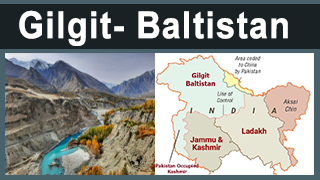Gilgit-Baltistan
CA INTERNATIONAL RELATIONS
Gilgit-Baltistan
Context:
- Valleys of Gilgit-Baltistan are resonating with loud protests by local communities against Pakistan for forcibly usurping village lands and plundering their natural wealth.
- Recently, a large number of people came out into the streets protesting against the Pakistan government’s decision to issue licenses to private contractors for mining gems.
Current Status of Gilgit-Baltistan:
- It is an autonomous region now and with this elevation, it will become the 5th province of the country.
- Currently, Pakistan has four provinces namely Balochistan, Khyber Pakhtunkhwa, Punjab, and Sindh.
India’s position:
- India has clearly conveyed to Pakistan that the entire Union Territories of Jammu and Kashmir and Ladakh, including the areas of Gilgit and Baltistan, are an integral part of the country by virtue of its fully legal and irrevocable accession.
Where is Gilgit Baltistan located?
- It borders China in the North, Afghanistan in the west and Kashmir in the south east.
- It shares a geographical boundary with Pakistan-occupied Kashmir.
- The region was a part of the erstwhile princely state of Jammu and Kashmir, but has been under Pakistan’s control since 4th November, 1947, following the invasion of Kashmir by tribal militias and the Pakistan army.
- The China Pakistan Economic Corridor passes through this region.
- Its present status:
- The area is currently under the occupation of Pakistan, in violation of the United Nations Commission for India and Pakistan (UNCIP) resolution of 28 April 1949.
- The occupation took place without the consent of the people of Gilgit-Baltistan and, despite the UNCIP’s calls for Pakistan to withdraw its forces from the disputed area, the occupation remains to this day.
- For over 60 years now, the area of Gilgit-Baltistan has lacked a proper constitutional status, a working legal system and political autonomy.
